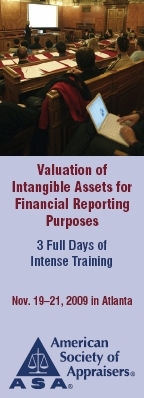
| Judges: Don’t get so intoxicated with your values What makes a financial expert credible to a court? That was just the first in a series of provocative questions that sparked a dynamic panel discussion among four judges at last Thursday’s BVR Summit on Business Valuation in Divorce, co-sponsored by NACVA and ASA in Chicago. Highlights: “I can tell you what makes an expert incredible: it’s being defensive,” offered Judge Jacqueline Silbermann (New York). If a judge or opposing attorney questions your valuation assumptions or facts—but you answer, “nothing will change, my report stands as it is,” then you risk losing your persuasive power. “Be prepared to recalculate your conclusion based on what the judge proposes,” Silbermann said. In other words, commented moderator Jay Fishman, “don’t get so intoxicated with your valuation conclusions. Be adaptable.” “Show reasonableness,” added Judge Moshe Jacobius (Illinois). In a market approach, for example, don’t compare your small subject company to a Fortune 500. Likewise, be sure to demonstrate “transparent objectivity,” said Judge Edward Jordan (Illinois). “If the witness comes across as a ‘hired gun,’ that gets my attention quickly,” he said, “and if that person’s credibility goes—it’s gone forever. I look for you to show me the objectivity and transparency of your opinion, so much that it comes up and bites me. Then I will listen very carefully to what you have to say.” Judge Howard Lipsey (Rhode Island) uses the smell test. “If it smells bad right off the bat, you know something is wrong, and all you have to do is figure out what that is.” Judges also don’t like the “wise-ass, defensive expert, who gets on the stand and says ‘I know everything’,” Lipsey said. “I look at them and say don’t B.S. me.” For a complete summary of all the judge’s comments, including their views on BV credentials, neutral experts—and their solutions to the recurring problem of “missing” discovery documents—catch the November Business Valuation Update™.
A panel of top-flight litigators followed the judges at the Chicago Divorce Summit, with candid comments on what they look for in financial experts:
One auditor’s expectations for 123R/409A valuations A top-flight valuation practice just had a call with the audit/valuation team at one of the Big 4 accounting firms, in which the auditors expressed several specific points to consider in the context of FAS123R, Share-Based Payments, and 409A valuations. Although we can’t name the players—their detailed conversation makes clear that each auditing team has its own expectations, so practitioners must talk to their auditors early, prior to any engagement:
Industry operating margins: sources and free samples One of BVR’s customers called with what appeared to be a pretty straightforward question last week: “How do I best benchmark my subject company’s operating margins compared to their industry?” As with all questions in business valuation, there are many answers… Obviously, there are the industry surveys (the October issue of Business Valuation Update has a feature on BizMiner; the November issue will have a review of improvements to RMA). But, there are other great sources of private company operating margins. In addition, operating margins are in Pratt’s Stats for private companies that have sold 100% of their interest (here’s a link to a sample—see the ‘operating profit margin’ at the bottom of the report). Public Stats also includes this information for public companies that have sold 100% of their interest: here’s that sample. “BizMiner will also satisfy your request. You’ll see from this sample that the operating margins for operating private companies (versus sold private companies) are included on page two of the report; look for ‘operating income’ and the margin is shown. Like Pratt’s Stats, this report compiles aggregate data rather than details from individual transactions. Lastly, the Mergerstat/BVR Control Premium Study also contains operating profit margins on public operating companies transferred at a control level (typically 100%). Here’s a sample.” Any questions about BVMarketData? Send us an email and we’ll be happy to help out. Are you a Thornhill expert? Remember the controversial In re Marriage of Thornhill, in which a Colorado trial court accepted a 33% discount for lack of marketability for a controlling (70%) interest in a $1.7 million oil and gas operation? (See BVWire™ #72-2.) On review, the appellate court confirmed the valuation—and rejected the wife’s argument that discounts should be precluded when valuing marital assets for divorce. The wife appealed the decision, and last Tuesday the Colorado Supreme Court heard arguments on whether the fair value standard should apply in matrimonial cases, according to Ron Seigneur (Seigneur Gustafson LLP, Lakewood, CO). “The discussion was fascinating—a packed room,” he told attendees at the Chicago Divorce Summit. Despite the focus on fair value, the judges probed discounts in general and the magnitude of the one in this case. For example, did the wife have the opportunity to remarket her interest? “She knew her options,” the attorney said, intimating that the wife could have sold to the other (30%) shareholder, who might have paid a premium to gain a controlling interest. “My sense from the discussion is that the judges were persuaded that the trial court did not abuse its discretion to apply the fair market value standard, including discounts,” Seigneur said. If so, this may be problematic for local BV practitioners, because Colorado is a “value to the holder” state. In fact, Seigneur is currently fielding calls from attorneys asking whether he is a “Thornhill guy”—i.e., if the majority interests in their cases can merit a 33% discount, too. He’ll keep us posted on the court’s final decision, due in about 60 to 90 days, which is sure to “spillover into other jurisdictions.” The appellate decision is posted at BVLaw™, as is the case abstract. More than one reason to attend the DLOM Summit. Keeping up with the current case law on marketability discounts is just one of many reasons to register for the 2nd Annual University of San Diego School of Law, Business Valuation and Tax Conference, coming up on October 9th. Other don’t-miss sessions include:
In the multi-million Microsoft remand: what would ktMINE find? After reporting the $358 million reversal of fortune in Lucent Technologies, Inc. v. Gateway, Inc., 2008-1485, -1487, -1495 (Sept. 11, 2009) (see BVWire# 84-2)—in which the court remanded the case for calculation of patent infringement damages, finding neither party’s evidence “powerful” or “well-presented“—we wondered what the experts would find at ktMINE in terms of comparable licensing agreements and reasonable royalty data. Save a few bucks: early bird price ends today for AICPA On-site interviews are still the appraiser’s best weapon
To ensure this email is delivered to your inbox, Copyright © 2009 by Business Valuation Resources, LLC
|
|
|



